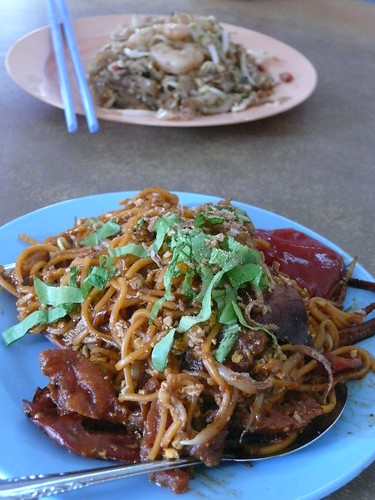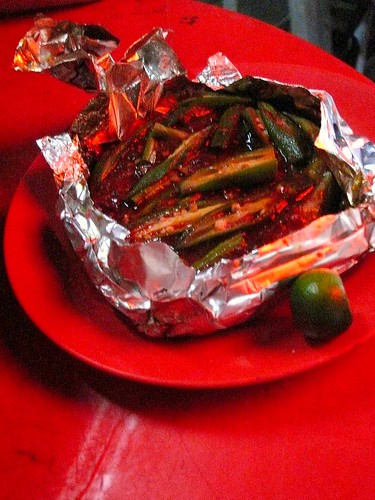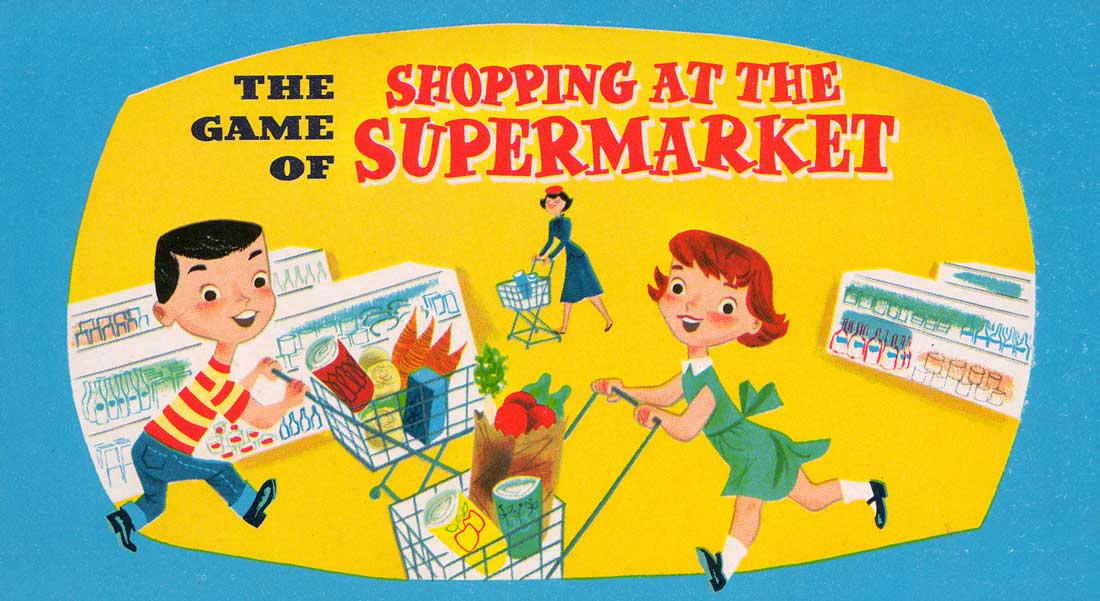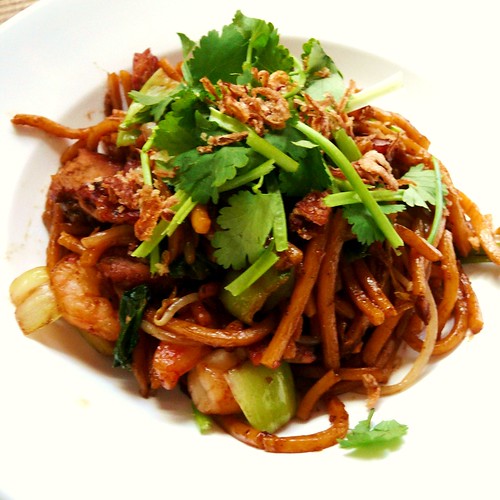
Dear Diary, it is day five of our holiday and Stickyfingers is still dropping food into her cleavage.
Mr Stickyfingers' Malaysian Holiday Diary, May 08
Hawker food. It excites me. Towards my middle age, sex is sadly becoming a distant dream, but the thought of hunkering down beside a cart to eat a simply prepared dish - that's native to an Asian culture - makes me positively rapturous.
Prolonged rhapsodising causes dribbling. Waiting for my order starts me trembling. And then on its arrival I bend in low over my dish, cup, bowl, plastic bag or paper and inhale deeply and rhythmically.
The first attempts to eat or drink are ham-fisted efforts just to get the comestible to my mouth. You see I tremble quite violently with excitement.
Quivering in my anticipation I botch any attempt at hand-mouth co-ordination. Plop! Food and drink hit my ample bosom, to grace me with yet another stain with which to match the faded one that I may have garnered earlier. In May I was so bad, I began to wonder if I should ask Mr Stickfingers to feed me my initial intake, before handing over the item as though to a small child?
Malaysian Hawker Food is definately at the top of my hawker food experiences. The range is enormous, never ending, and somehow the locals manage to graze all day on it without gaining weight. I want their metabolisms and bottomless pits of bellies, their ability to eat palm oil fried everything and coconut flavoured foods without having cholesterol issues and I want a gut and mouth that can withstand a lick of Hades infused chilli.
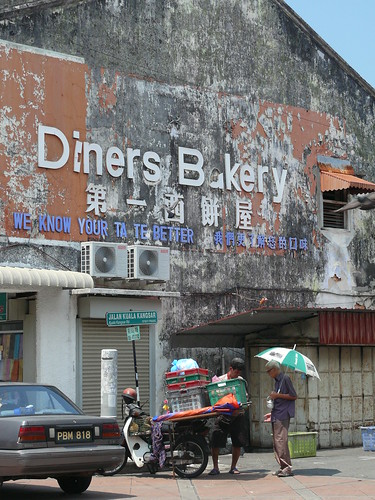
In Malaysia we eschewed restaurants in favour of hawker food. The lure of restaurants paled into insignificance beside dishes we could never eat back home. In fact, eating in restaurants felt oddly ostentatious there and removed from local culture. So to food courts and hawker centres we went.
Dripping with sweat by roadsides we slurped slippery noodles while hunkered on low plastic stools. We ate samosas at a cart outside a wet market, Kerupok from a cart on a beach, hot biscuits from the back of van parked outside a hotel, chestnuts from the back of a bike and heavenly barbecued chicken in an abandoned carpark late at night. Smoke billowing down a street led us to the best satay EVER and to Onion Roti Paratha, a firey Nonya fish made with sting ray and to claypot sausage rice.

In Penang our appropriately named new friend, Chew Fa Ming, led us through a merry dance of delectable hawker treats, and frankly why wouldn't you? He seemed to know so many of the hawkers personally, selecting wonderful dishes for us, and introducing us to fruit we had not seen before in our travels. What a Godsend! We were in heaven. Days later we were tramping around the back streets for wonderful Hainan Chicken Rice, Char Kway Teow, Mee Goreng, Dosai, Banana Naan, various Kuih and Murtabak.
Back at home I also cook Malaysian hawker food. You've seen my Satay, Rendang, Char kway Kak and Mee Goreng recipes, and although delicious, they will never match the flavour of charcoal cooked food or the taste of the char of a well seasoned wok, searing over jet blastingly ferocious heat.
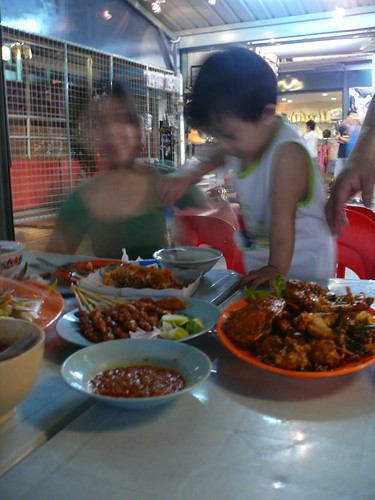
One of the reasons I love to cook hawker dishes is that it is quicker to pull together than many Western foods on a work night and because it is quick and intense, it can be quite healthy if you avoid their chosen fats palm oil and lard. Naturally the flavour suffers a little without the appropriate fats, but I do try to be healthy at home. Thankfully in Australia most of the produce is locally grown too, and it's easy to get Asian groceries in the urban sprawl.
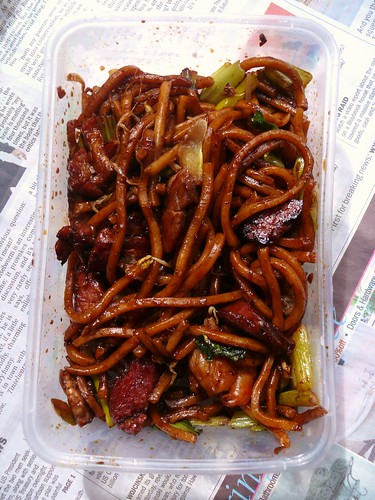
And then, there are the great leftovers. Here's my lunch - leftover Hokkien Mee. Basically the same ingredients as Mee Goreng, but substituting a dark soy based sauce for the potato and tomato curry sauce.
I love it when I open up a take away container of hawker noodles at an office and sniffing with enthusiasm, colleagues ask me where I bought my lunch? Once, a vegetarian was so enticed, as to prevail upon me for a taste of my Char Kway Teow, and loved it. But then gutted, acted as though I'd poisoned him when he found out it contained meat. He didn't tell me he was a vegetarian and you could plainly see it contained meat. Go figure?
In the not too distant future I will again be packing the baby wipes to remove stains from t.shirts worn while eating more hawker food. This time we will be heading back to Vietnam and Thailand, with a side trip to Laos for a spot of Flashpacking. That's moderately more comfortable backpacking for old farts who love an adventure on a budget.
Mr Stickyfingers will most probably spend his birthday basking on a white sandy beach eating food on a stick, cooked on a portable brazier by a hawker. Can't wait.

Hokkien Mee
500g/1 packet fresh Hokkien noodles
1 tablespoon oil
1 large clove garlic, minced
150g sliced chicken breast
150g fresh prawns, peeled & deveined
150g squid, cut into bite sized pieces and scored
2 cups sliced bok choy or mustard greens
1 cup bean shoots
Sambal Oelek or Sriracha (chilli sauce)
Optional
fried tofu, sliced
Cha Sui cubes (BBQ Pork)
Chinese Sausage slices (roasted or wind dried)
Oriental Fish Cake, sliced
Garlic shoots, chopped into 15mm lengths
Sauce
2 & half tablespoons black soy sauce or Ketchup Manis
1 tablespoon light soy sauce
1 tablespoon Oyster sauce
2 teaspoons sugar
salt and pepper to taste
2 teaspoons cornflour
1 cup water
Serve with lime, extra chilli and Sambal Belanchan
Mix all sauce ingredients in a bowl and set aside.
Warm oil in a hot pan/wok and brown the chicken, add garlic, squid and prawns. Fry until golden, also aiming to char them a little. Add any of the optional items and heat through.
Throw in the noodles and fry until warmed through.
Heat the sauce briefly in the microwave until just warm, then stir into the noodles, distributing evenly.
Throw in the greens and bean shoots and add a couple of teaspoons of water if the sauce has been totally absorbed by the noodles. Cook until the vegetables are softened and bright green. Extra Ketchup Manis may be added to taste at this point, along with the chilli sauce or extra pepper. Sichuan pepper is excellent in this dish if you have it.
Serve garnished with coriander, lime and fried shallots. Place a bowl of Sambal Belanchan and chilli alongside the dish for extra seasoning.
